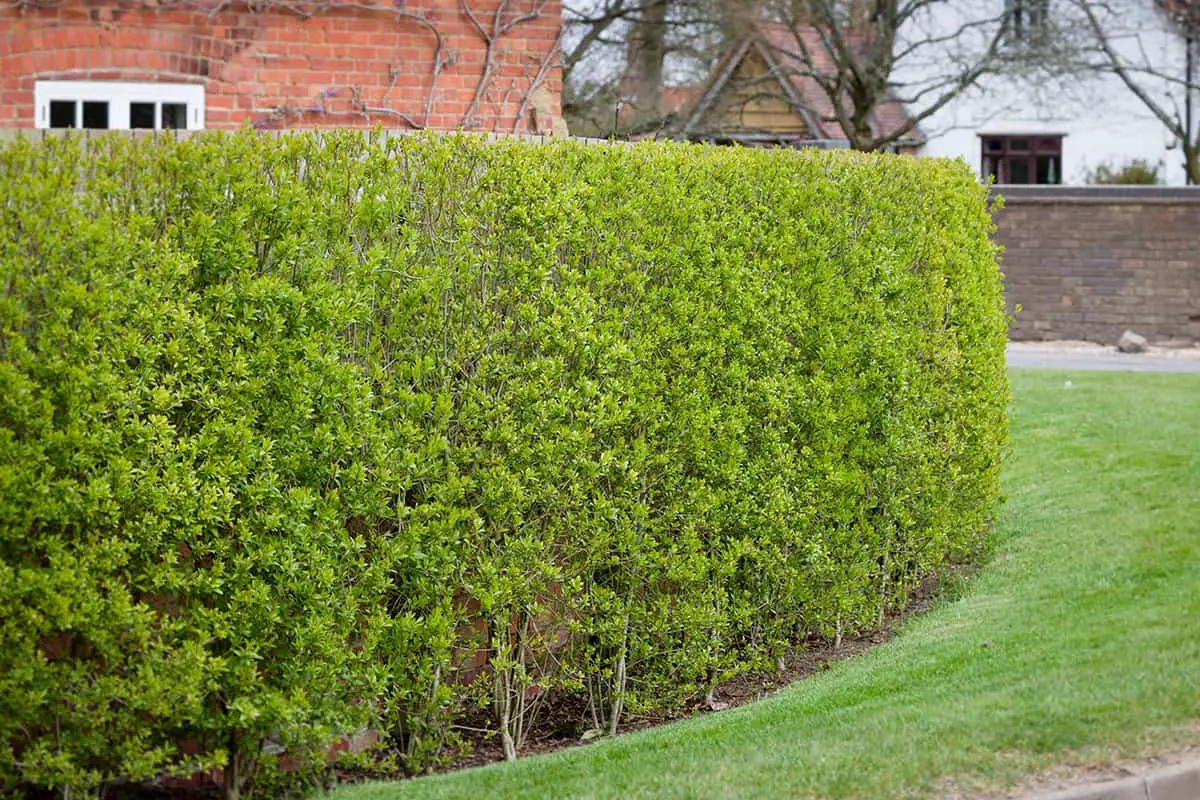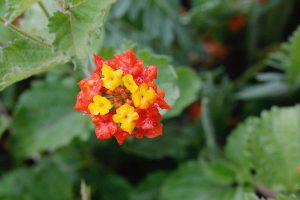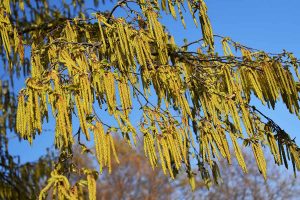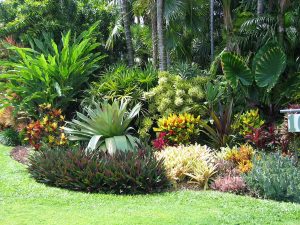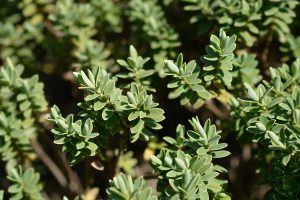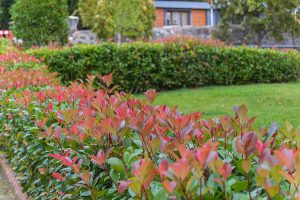If you want to create privacy screening around the perimeter of your home, then your options are likely limited to erecting a fence or wall or growing a screening or hedge made from plants. Fences and walls have the obvious benefit of being pretty much instant, but they can look harsh against the landscape and make your garden feel like a prison. Neighbors might also be offended that you want to block them out.
A hedge or screening has a much more aesthetically pleasing look, which will blend into the landscape because, of course, it is made from entirely natural plants. The drawback of using plants for privacy screening is the fact that they can take many years to reach a height that actually works as a screen.
If you want a shrub screen but don’t want to wait a decade for it to mature, consider fast-growing species that will gain height more quickly. Here we look at a range of fast-growing evergreen shrubs that can be used for screening.
Table of Contents
What is Shrub Screening?
Shrub screening, also known as privacy screening, is a type of hedge. While hedges are considered to be quite formal since they are usually neatly pruned to maintain a certain shape, screening has a more casual look because the plants are allowed to grow in their natural shape.
A shrub screening is created by planting a row of shrubs close together, typically a few feet apart, depending on the expected spread of the mature shrub.
For example, if you are using a shrub with an expected mature spread of 3 feet, you should plant the shrubs with a distance of 2 feet between the center of each shrub, allowing them to spread and merge together with no gaps in between.
Shrub screening can be used around the entire perimeter of a garden, or you can use it in the middle of a garden to cordon off a space, for example, to create a more intimate outdoor dining area.
Evergreen of Deciduous Shrubs for Screening?
Evergreen shrubs hold onto their foliage through every season of the year, whereas deciduous shrubs shed their leaves, usually in fall or winter. This means the branches of a deciduous shrub remain bare throughout winter, typically until spring the following year when new leaves emerge on the plant.
You might expect that this means evergreen shrubs are the only types of shrubs that can remain attractive all year round; however, this isn’t the case.
Many deciduous shrubs have an appealing silhouette when their branches are bare, or they might have an unusual color of bark which is revealed when the leaves are no longer hiding the branches. In these instances, deciduous trees are able to retain interest throughout the winter garden.
However, deciduous shrubs can be a problem when it comes to using your plants as screening. When you have created a row of plants for privacy screening or hedging, you have intentionally positioned them in a way that prevents outsiders from seeing into your home and garden, or you may have positioned this way to block out an unappealing view so you can’t see it from your home windows.
Unfortunately, since deciduous plants do not have any leaves throughout winter, this will mean that a screening made from deciduous shrubs will no longer offer the privacy it did during the summer months. Even deciduous shrubs which are densely branched will still have gaps during winter which would previously have been hidden by leaves.
This means that if it is important to know that your screening remains fully intact and functional through every month of the year, you’ll need to choose an evergreen species. Evergreen shrubs with dense foliage make the best choice since they will entirely block out the view between your home and the street.
Mexican Orange Blossom
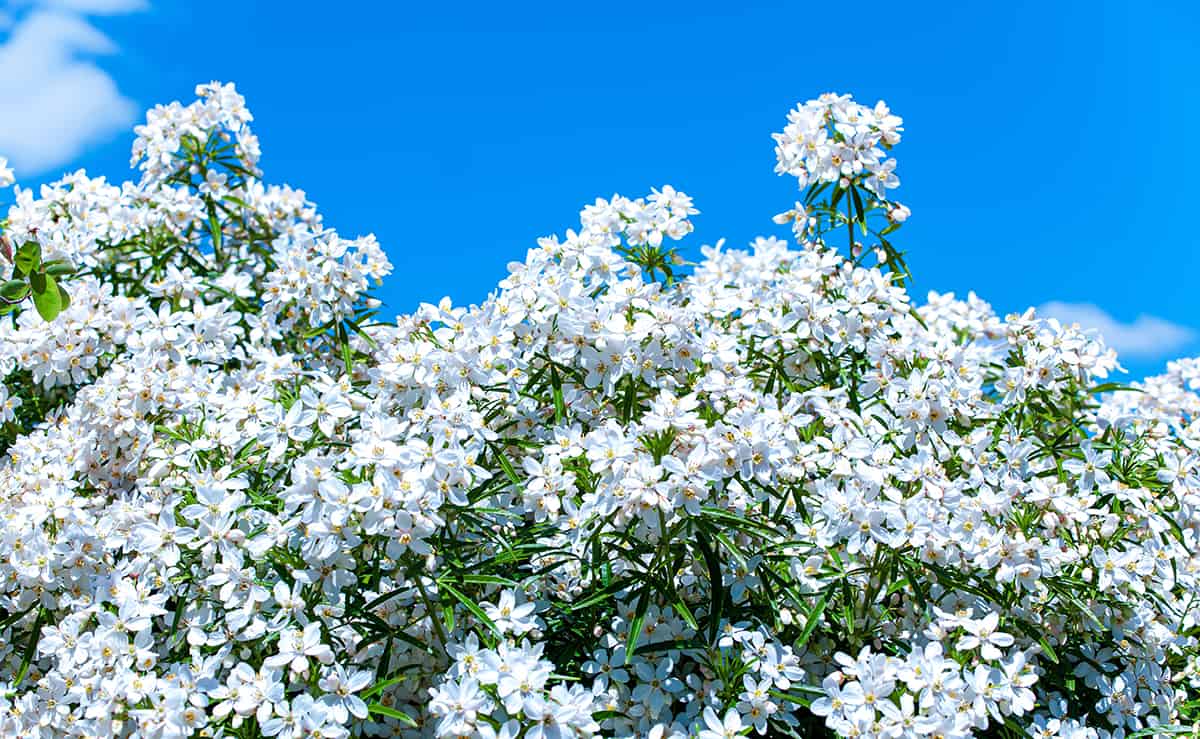
- Botanical name: Choisya ternata
- Family: Rutaceae
- USDA hardiness zones: 7- 10
- Mature height: 6 to 8 feet
- Mature spread: 6 to 8 feet
This is an evergreen shrub that grows natively in both the southern United States and in Mexico. It grows at a typical speed of 2 feet per year, which means you could have a 6-foot-tall privacy screening in the space of just 3 years.
After 4 years, the screening would have reached the plant’s mature height of between 6 and 8 feet, which is taller than most domestic garden fences. The Mexican Orange Blossom will create an attractive screening since it produces pretty flowers in white and glossy green leaves.
Both the leaves and flowers will release a sweet orange scent when they are crushed. The typical spread of this plant is 8 feet in width, so to create a screening, you should position the center of each plant at a distance of 7 feet from the next. Mexican Cherry Blossom thrives in full sun and prefers soils that are rich in organic content and drain well.
Firethorn
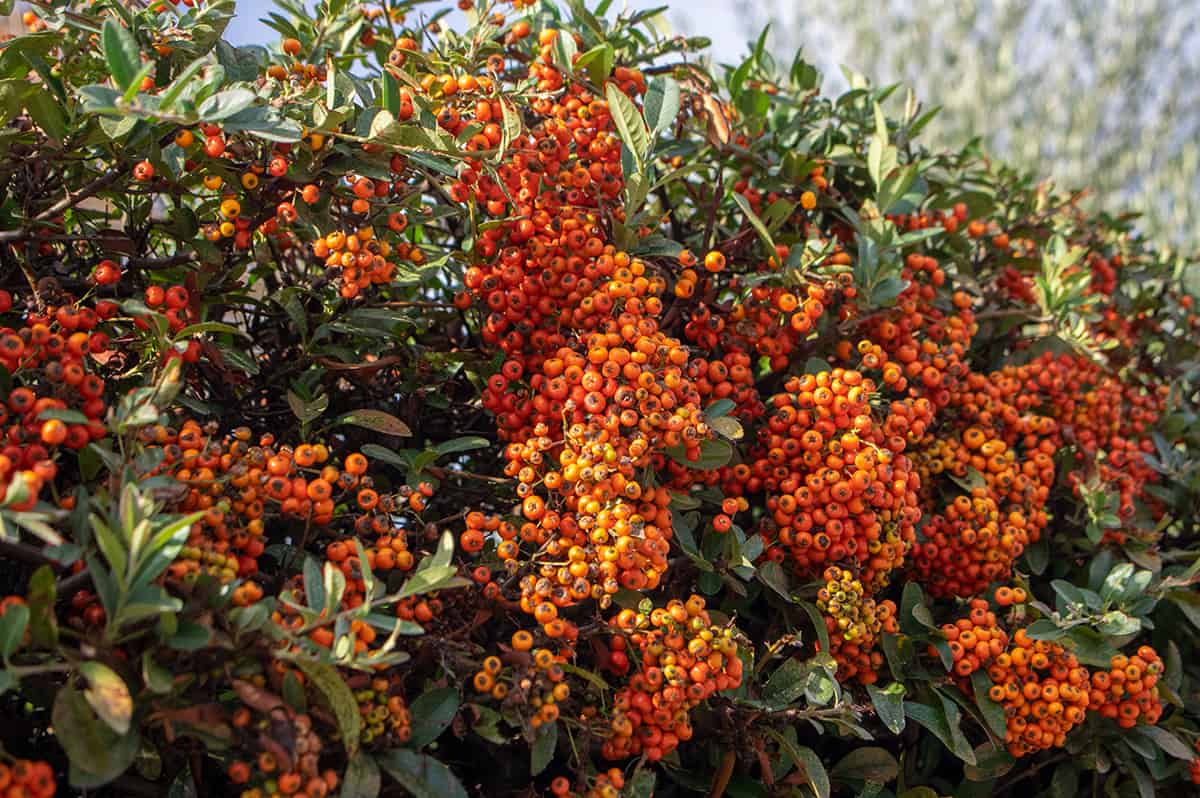
- Botanical name: Pyracantha
- Family: Rosaceae
- USDA hardiness zones: 5- 9
- Mature height: 4 to 12 feet
- Mature spread: 3 to 10 feet
Pyracantha, more commonly known as Firethorns, are a genus of evergreen shrubs. These are known to be moderate to fast growers, but the variety which is most famed for its speed of growth is the Pyracantha coccinea ‘Red Column’.
This variety can grow to a maximum height of 12 feet, gaining approximately 2 feet in height each year. Another Firethorn with a similarly fast rate of growth is the Pyracantha koidzumii ‘Victory’, which has a slightly smaller mature height of around 8 feet. With an expected growth rate of 2 feet per year, this variety of Firethorn will typically have reached its maximum size in just four year, creating a dense evergreen screening in a remarkable space of time.
Firethorns are known for their showy berries, which follow small white flowers. The berries hang in dense clusters of glossy fruits and can be orange, red, or yellow. These plants thrive in positions of full sun and can tolerate drought once well established.
They are an excellent choice for privacy screening because of their dense growth habit, their fast-growing nature, and the fact that they remain evergreen and, therefore, will function as privacy screening throughout every month of the year. If you prefer a more pruned look, this plant will need to be trimmed annually, but it tolerates pruning well.
Escallonia
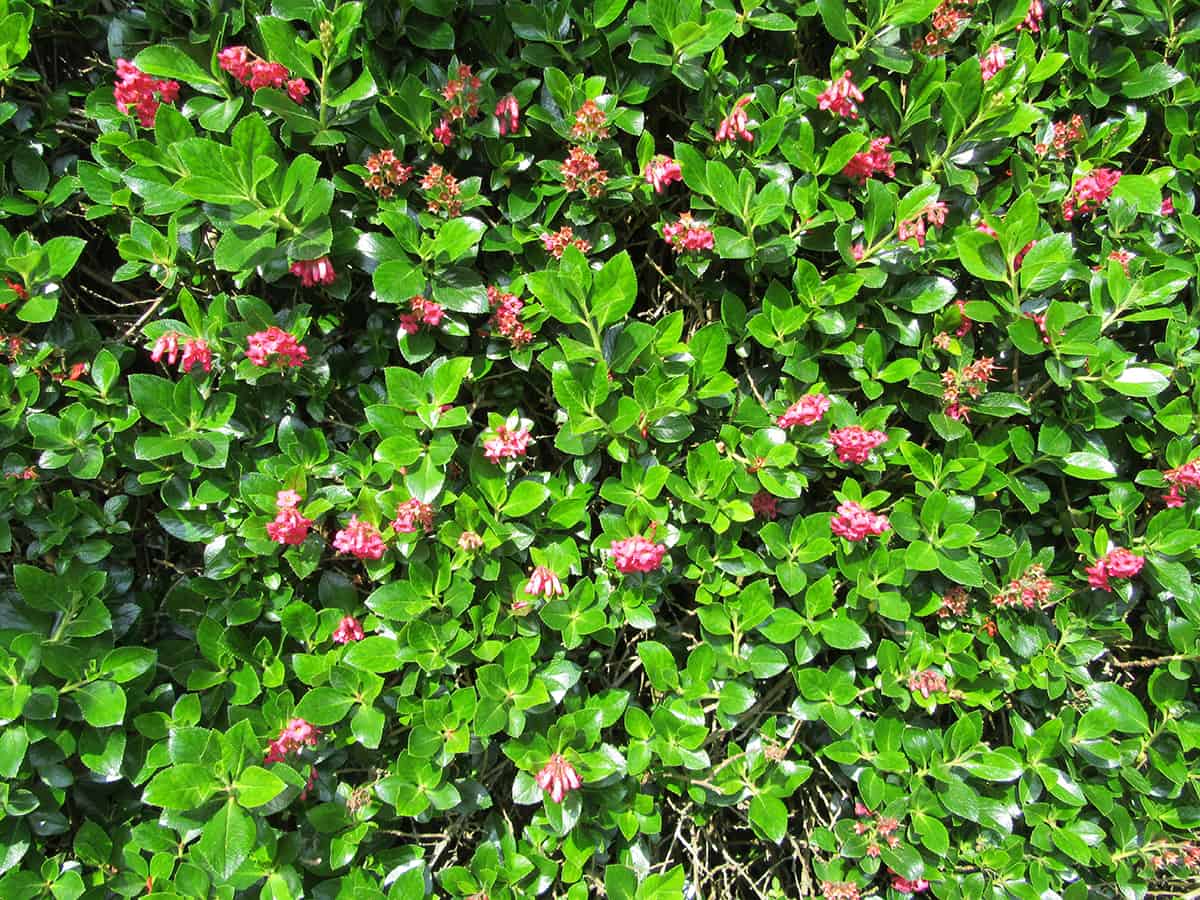
- Botanical name: Escallonia sp.
- Family: Escalloniaceae
- USDA hardiness zones: 8- 10
- Mature height: Up to 15 feet
- Mature spread: Up to 15 feet
Escallonia is a genus of plants that are renowned for their ability to grow quickly and thrive with very little care. You can expect a typical rate of growth of between 1 and 2 feet per year, which means that in order to reach a height of 6 feet, your screening would take anywhere from 3 to 6 years to grow.
Many Escallonia shrubs can grow to heights of up to 15 feet, and this mature height would be reached in anywhere from 7 and a half to 15 years. Although Escallonia is by no means the fastest-growing evergreen shrub, it is still considered very fast compared with the average speed of growth amongst evergreen shrubs, and Escallonias are exceptionally attractive, which makes them ideal for screening.
They produce flowers that can be white, pink, or red, and these appear on heavy panicles during summer, with some varieties able to continue blooming right through to fall. The foliage of the shrub is also appealing, which means the screening will retain its pleasing look through every season.
The leaves have a glossy finish and are a medium-green shade. Escallonia shrubs grow easily in full sun and well-draining soils. Watch out for fungal disease on Escallonia leaves since these plants are particularly susceptible to this issue. Ensuring good airflow between the branches will help to decrease the likelihood of this problem occurring, especially during summer months when the air can be quite humid. You can do this by thinning the branches out with selective pruning.
Murray Cypress
- Botanical name: X Cupressocyparis leylandii ‘Murray’
- Family: Cupressaceae
- USDA hardiness zones: 6 – 10
- Mature height: 30 to 40 feet
- Mature spread: 6 to 10 feet
The Murray Cypress is a type of evergreen conifer that takes the shape of an enormous shrub. It is believed to be the result of a hybridization, and has become hugely popular as an extremely fast-growing solution for creating hedging and privacy screening. The rate of growth on this impressive tree is an unbelievable 4 feet per year.
This means that in the space of just two years, you could have an 8-foot screening surrounding the perimeter of your garden. In 3 years, the screening will have reached a whopping 12 feet, and this will continue until the shrub reaches its ultimate height of between 30 and 40 feet.
If you would prefer not to have such a tall screening since it will create a lot of shade in the garden, you can prune it back annually to maintain a more manageable height. The Murray Cypress should be planted at a distance of 3 or 4 feet between each plant if you want a dense privacy hedge, or this can be relaxed to a distance of 6 to 7 feet between each plant for a more casual screening.
The shrub is very tolerant of harsh winds, so it is also an excellent choice to use as a windbreak. It will tolerate salt, which means it can also be put to good use in coastal regions. This is an exceptionally easy to grow tree, which thrives in both full sun or partial shade, and will adapt to any type of soil. It prefers a moderately moist soil, but it can also sustain itself in periods of drought once established, and it will also tolerate wet soils.
Green Giant Arborvitae
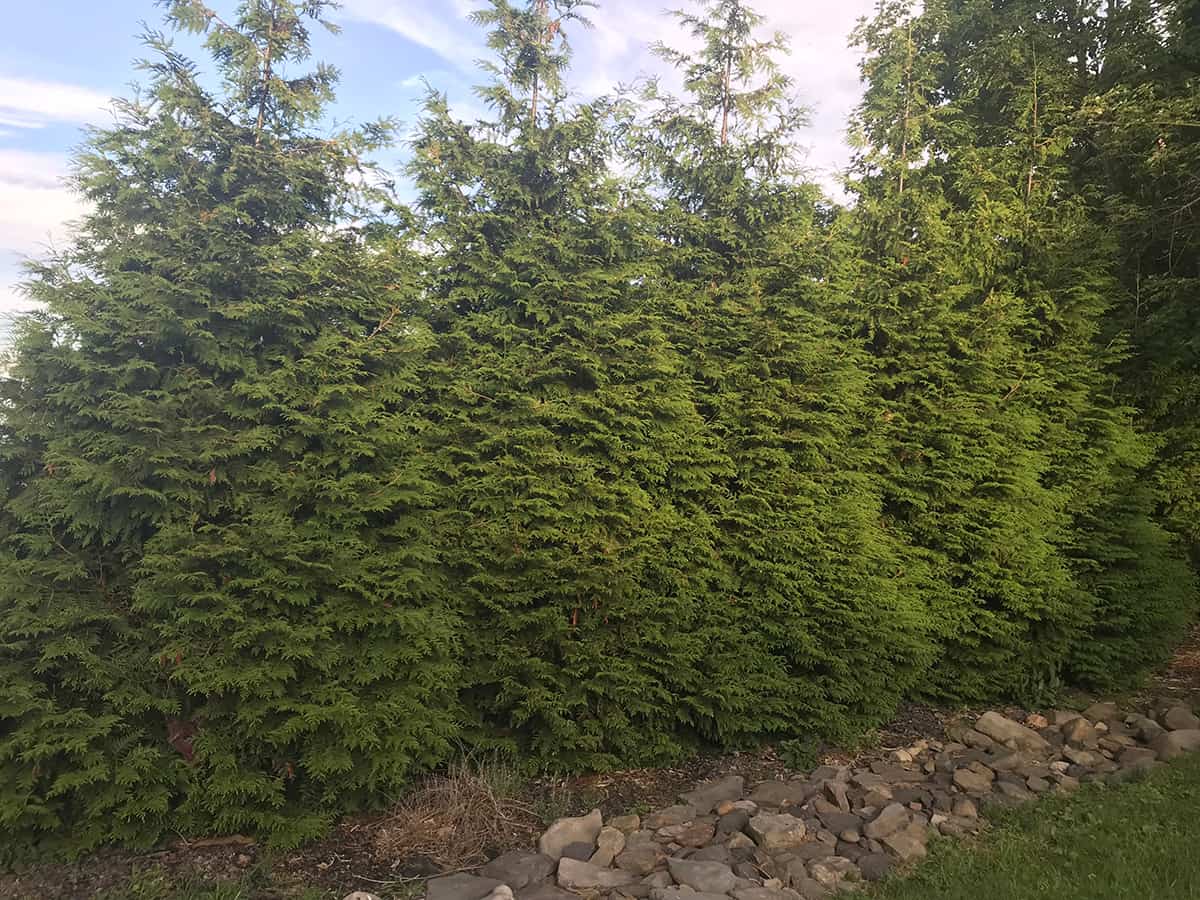
- Botanical name: Thuja standishii x plicata ‘Green Giant’
- Family: Cupressaceae
- USDA hardiness zones: 5 – 7
- Mature height: 50 to 60 feet
- Mature spread: 12 to 20 feet
This coniferous evergreen shrub is known for its huge height and slender shape, but it is also very popular thanks to its exceptional speed of growth. This plant will typically grow at a rate of 3 feet per year and has even been known to gain as much as 5 feet in height in a single year.
On average, you can expect to have a 12-foot screening in just 4 years if you plant a Green Giant Arborvitae in your garden. When planting this species to form a screening or hedge, it should be positioned in rows with a distance of 5 to 6 feet between each plant. This is an award-winning plant that received the Pennsylvania Horticultural Society Gold Medal Plant Award in 1998.
It features scale-like flattened leaves in a glossy green color, and these are arranged in tightly packed, overlapping rows, helping to create a dense shrub that will help to block out light, sound, and wind when used as a screening. The plant is a result of a hybridization performed in Denmark, and from this, an individual plant was sent to the U.S. National Arboretum in 1967.
From here, the plant was propagated and widely distributed. It is now one of the most popular varieties of Arborvitae, and is considered as the best replacement for the Leyland Cypress (Cupressus × leylandii), which is highly susceptible to pests and disease. By comparison, the Green Giant Arborvitae has no known serious issues with disease or pest infestations. It is easy to grow and thrives in a range of conditions. Grow this plant in full sun or partial shade.
It will adapt well to almost any type of soil, though wet soils should be avoided. The plant is sensitive to salt, so it is not suitable for planting in coastal regions. It does not need to be pruned but tolerates pruning well.
